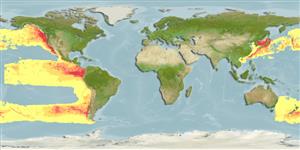>
Alepocephaliformes (Slickheads and tubeshoulders.) >
Alepocephalidae (Slickheads)
Etymology: Alepocephalus: Greek, alepos, alepidotos = without scales + Greek, kephale = head (Ref. 45335); tenebrosus: tenebrosus meaning dark or gloomy, coming from the great depths where not even shadows occur..
More on author: Gilbert.
Environment: milieu / climate zone / depth range / distribution range
Ecologia
marinhas batidemersal; intervalo de profundidade 46 - 5500 m (Ref. 4525). Deep-water
North Pacific: Bering Sea to at least California, USA. Southeast Pacific: Chile (Ref. 35724).
Tamanho / Peso / Idade
Maturity: Lm ? range ? - ? cm
Max length : 61.0 cm TL macho/indeterminado; (Ref. 2850)
Descrição breve
Chaves de identificação | Morfologia | Morfometria
Espinhos dorsais (total) : 0; Raios dorsais moles (total) : 15 - 18; Espinhos anais: 0; Raios anais moles: 15 - 18; Vértebras: 51 - 55. Branchiostegal rays: 6-7.
Found near or on bottoms (Ref. 2850). Feed on small crustaceans. Regarded as inferior food because of its soft, fleshy texture (Ref. 4525). Oviparous, with mesopelagic and bathypelagic larvae (Ref. 35724).
Life cycle and mating behavior
Maturities | Reprodução | Spawnings | Egg(s) | Fecundities | Larvas
Eschmeyer, W.N., E.S. Herald and H. Hammann, 1983. A field guide to Pacific coast fishes of North America. Boston (MA, USA): Houghton Mifflin Company. xii+336 p. (Ref. 2850)
Categoria na Lista Vermelha da IUCN (Ref. 130435)
Ameaça para o homem
Harmless
Utilização humana
Ferramentas
Relatórios especiais
Descarregue XML
Fontes da internet
Estimates based on models
Preferred temperature (Ref.
123201): 0.2 - 4.1, mean 2.3 °C (based on 389 cells).
Phylogenetic diversity index (Ref.
82804): PD
50 = 0.5000 [Uniqueness, from 0.5 = low to 2.0 = high].
Bayesian length-weight: a=0.00347 (0.00164 - 0.00733), b=3.19 (3.00 - 3.38), in cm total length, based on LWR estimates for this (Sub)family-body shape (Ref.
93245).
Nível Trófico (Ref.
69278): 3.5 ±0.50 se; based on food items.
Generation time: 3.7 ( na - na) years. Estimated as median ln(3)/K based on 1
growth studies.
Resiliência (Ref.
120179): Médio, tempo mínimo de duplicação da população 1,4 - 4,4 anos (K=0.30).
Fishing Vulnerability (Ref.
59153): Moderate vulnerability (43 of 100).
